HD-ready PMP ships with Plaszma Linux SDK
Jul 29, 2009 — by Eric Brown — from the LinuxDevices Archive — 20 views Creative Technology subsidiary ZiiLabs is shipping a developer-focused portable media player based on a homegrown, dual ARM-core “ZMS-05” SoC and “Plaszma” Linux distribution. The Zii Egg StemCell Computer offers a 3.5-inch display supporting 1080p HD video, plus an HD video camera, WiFi, GPS, Bluetooth, an SDK, and optional Android, says ZiiLabs.
Creative Technology subsidiary ZiiLabs is shipping a developer-focused portable media player based on a homegrown, dual ARM-core “ZMS-05” SoC and “Plaszma” Linux distribution. The Zii Egg StemCell Computer offers a 3.5-inch display supporting 1080p HD video, plus an HD video camera, WiFi, GPS, Bluetooth, an SDK, and optional Android, says ZiiLabs.
ZiiLabs was founded in 1994 as the fabless semiconductor firm 3DLabs, which specialized in multimedia applications processors. In January, 3DLabs was integrated with the Personal Digital Entertainment group of Creative Technology, forming the wholly owned subsidiary ZiiLabs.
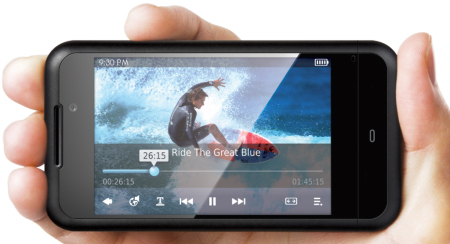
Zii Egg
(Click to enlarge)
The $200 PMP (in volume) ships with a Linux-based SDK and open development platform aimed at OEMs and the general developer community. Although primarily designed for consumer PMP use, non-consumer applications are said to include a network of WiFi-connected HDTV digital signboards. Presumably the "Egg StemCell" name is meant to suggest a base platform that can be spun off into a variety of different forms, stem-cell style.

Zii Egg group photo
(Click to enlarge)
The ZMS-05 is said to be equipped with dual ARM926 EJ-S cores, as well as 24 floating-point processors that deliver up to 8 GFLOPS of raw processing power. The chip's 3D OpenGL ES capability helps support the development of 3D games and applications boasting 42 million textured pixels/sec fill rate, claims ZiiLabs. The SoC is also available as part of a computer module called the ZMS-05 System Module (See farther below for more on the ZMS-05 and the module).
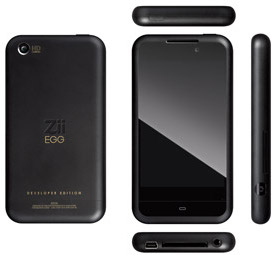
Different sides of Zii Egg
The device's 3.5-inch, 320 x 480 capacitive touchscreen offers 10-point multi-gesture touch support, with the capacity for customized gesture commands, says ZiiLabs. The touch- and gesture support is said to enable the development of applications such as a virtual piano, where users could play chords with onscreen keys. The device can output 720p and 1080p HD video to HDTVs via a docking connector that supports an HDMI cable.
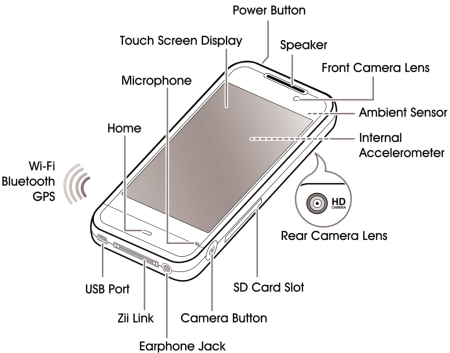
Zii Egg features
(Click to enlarge)
Specifications listed for the Zii Egg include:
- Processor — ZiiLabs ZMS-05 (dual ARM926 EJ-S cores); clock rate unspecified
- Memory — 256MB Mobile DDR
- Flash — Up to 32GB internal flash; 32MB NOR Flash (Linux Kernel Boot ROM)
- Flash expansion — SDHC slot for up to 32GB
- Display — 3.5-inch, 320 x 480, true-color, capacitive LCD with 10-point multi-gesture touch
- Video — supports 720p and 1080p HDTVs via HD cable
- Video out — Universal Docking connector supporting HDMI, USB, Audio Line-In/Line-Out, Composite-In/Out, UART
- Audio — X-Fi audio processing; built-in speaker and microphone; headphone socket
- USB — USB 2.0 Mini-B (MTP and charging)
- WiFi — 802.11 b/g
- Bluetooth — Bluetooth 2.1 + EDR
- GPS — Hardware GPS receiver
- Cameras — Forward-facing VGA still camera; rear-facing HD camera
- Other features — 3-axis accelerometer; ambient light sensor
- Software — Music and video player; photo browser; Opera 9.7 web browser
- Dimensions — 4.5 x 2.4 x 0.5 inches (115 x 62 x 12mm)
- Weight — 3.8 oz (108 g)
- Battery — 1200mAH rechargeable lithium-ion
- Operating system — Plaszma OS (Linux-based); or Zii Optimized Android
Zii Plaszma Platform
ZiiLabs offers a Zii Plaszma Platform, which it describes as "a complete portfolio of hardware platforms and software solutions based around the ZiiLabs ZMS processors." The platform includes a Zii Egg StemCell Computer, a ZMS-05 System Module (see farther below), the Plaszma OS, and the Plaszma software development kit (SDK).
For those who prefer Android, ZiiLabs has also bundled a "Zii Optimised Android" distribution that is designed to get the most out of the ZMS-05 processor. (See the video at the end of the story for a demo of Android running on the Zii Egg.)
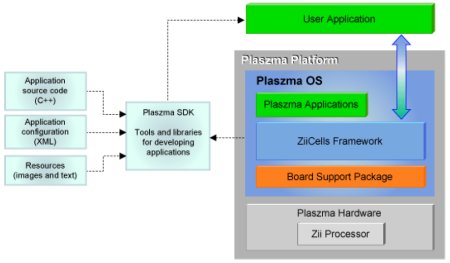
Zii Plaszma Platform architecture
(Click to enlarge)
The Cell framework (pictured below) includes a set of optimized "industry standard" APIs organized in "cells" of related functions. The APIs cover multimedia codecs, as well as video, image, and audio playback and recording. The APIs also cover "advanced audio processing, including a text-to-speech engine," says ZiiLabs.
The Plaszma OS distribution is said to ship with an Opera 9.7 browser, 2D graphics software, OpenGL ES 3D graphics, and a gesture-based user interface.
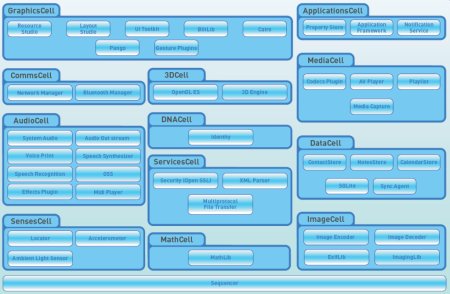
Plaszma Cell Framework
(Click to enlarge)
- Native C/C++ development
- Wide range of supported video, image and audio formats
- Cell Framework of industry standard APIs and libraries
- 2D and vector graphics, compositing, and blending
- OpenGL ES 3D graphics
- HD media playback and recording framework
- Multi-touch, gesture-based UI
- Opera 9.7 web browser supporting CSS, XHTML, JavaScript, and Ajax
- Adobe Flash Lite 3.1 (not yet shipping)
- Internationalization and localization features
- Integrated database
- Network services and event management
- Sensor handling for accelerometer, GPS, ambient light
ZMS-05 System Module
The ZMS-05 System Module available with the Zii Plaszma Platform includes standard Zii Egg mainboard features, as well as additional interfaces for development purposes. These include an Ethernet controller, a JTAG port, and I2S and I2C interfaces. It also ships with a Linux/Plaszma BSP.
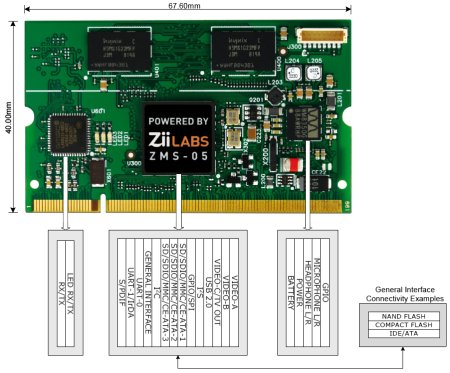
ZMS-05 System Module
(Click to enlarge)
- ZMS-05 processor
- 256MB 64-bit Mobile DDR Memory
- 16MB NOR Boot ROM
- Power management unit
- Stereo audio DAC
- 10/100 Ethernet controller
- USB PHY High Speed OTG port
- JTAG diagnostics port
- Analog audio port
- 3 x video input/output ports
- Analog HDTV encoder
- USB 2.0 OTG controller with PHY
- 3 x SD/SDIO/MMC/CE-ATA
- 2 x 3Mbps UART
- I2S
- S/DPIF
- I2C
- General interface
- 67.6 x 40.0 x 3.8mm dimensions
- 200-pin SODIMM connector and module (compatible with 2V5 and 1V8 SODIMM connectors)
- BSP:
- Linux 2.6 kernel
- Customizable Boot-loader
- USB recovery app
- Recovery RAM file-system image
- JFFS2 file system with configuration data.
- Reference drivers supporting LCD displays, camera sensors, HDMI, flash memory, WiFi, Bluetooth, etc.
ZMS-05 processor
The ZMS-05 SoC that drives the Zii Egg combines dual ARM926 EJ-S cores, with one core typically running the OS, and the other acting as the applications co-processor, says ZiiLabs. The SoC features a "high compute density" SIMD architecture aimed at media processing tasks such as video, imaging, 2D/3D graphics, audio, and signal processing. The SoC also provides Integer and IEEE 32-bit and 16-bit floats, says ZiiLabs.
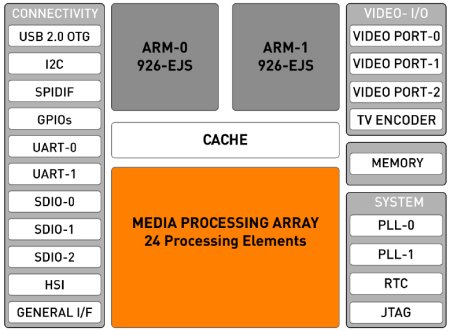
ZMS-05 block diagram
(Click to enlarge)
- Dual ARM926 EJ-S cores
- 24 floating point processors with 8GFLOPS
- 64/32-bit memory bus
- NAND and NOR
- SD/SDIO/MMC/CE-ATA
- Wide range of optimized codecs
- Accelerated OpenGL ES 3D graphics
- 2D graphics, blending, and compositing
- Advanced image processing
- Fully programmable
- Multiple HD video I/O ports
- USB 2.0
- Serial connectivity including I2S, I2C, GPIO, SPI, UART
- General interface bus
- HDTV encoder
- Low-power design
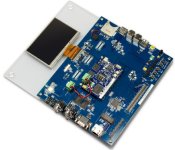 |
Finally ZiiLabs offers a general-purpose ZMS-05 Evaluation Module (EVM) for the ZMS-05 that is not linked exclusively to the Zii Egg platform. The EVM includes a board (shown at right) that offers additional connectivity beyond what is available with the ZMS-05 System Module. A Linux BSP is also supplied. (More information on the EVM and the ZMS processor may be found in this PDF.)
Stated Hock Leow, President of ZiiLabs, "Zii StemCell Computing Technology and the Zii Plaszma Platform are the direct results of our $1 billion investment including 10,000 man years of R&D effort in developing platform and chip solutions. We've worked diligently on the design, from the chip and board, to OS integration and CODEC support, all the way to device design, mechanical tooling, and standards compliance to ensure that innovators are freed from the complexities of hardware and software development."
Zii Egg running Android demo
Availability
A Plaszma SDK Starter Kit is now available for immediate purchase at $400, which includes the Plaszma OS, Plaszma SDK, and the Zii Optimised Android OS. As an introductory offer, the Starter Kit is available with a free Zii Egg handheld with a 32GB SD card. The Zii Egg otherwise sells for $200 in volume, apparently without the SD card. The Android after-sales installer upgrade will be available soon, says ZiiLabs.
No price was offered for the ZMS-05 System Module, the ZMS-05 EVM, or the ZMS-05 processor. More information, including extensive documentation on the Zii Egg, the System Module, EVM, and ZMS-05 itself, may be found here.
This article was originally published on LinuxDevices.com and has been donated to the open source community by QuinStreet Inc. Please visit LinuxToday.com for up-to-date news and articles about Linux and open source.